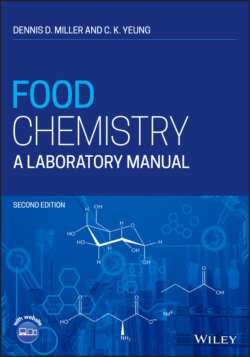Читать книгу Food Chemistry - Dennis D. Miller - Страница 50
Оглавление3 Properties of Sugars
3.1 Learning Outcomes
After completing this exercise, students will be able to:
1 Draw structures of common reducing and nonreducing sugars.
2 Explain the difference between a hemiacetal and an acetal.
3 Distinguish between reducing and nonreducing sugars experimentally.
3.2 Introduction
Sugars are polyhydroxylated aldehydes or polyhydroxylated ketones (Figure 3.1). Thus, they participate in reactions characteristic of alcohols and aldehydes or ketones. Please review the sections in your organic chemistry textbook that describe reactions for alcohols, aldehydes, and ketones.
Recall that alcohols react reversibly with aldehydes or ketones to form hemiacetals or hemiketals. When the alcohol and carbonyl groups are on the same molecule, as is the case with sugars, a cyclic or ring structure is formed (Figure 3.2).
Note that hemiacetals contain a carbon atom bonded to an –OH group and an –O–R group. Hemiacetals are relatively unstable. In aqueous solution, the open and closed ring forms are both present in equilibrium. Thus, sugars like glucose participate in reactions characteristic of aldehydes even though the predominant form is the hemiacetal.
Sugars containing the hemiacetal group are called reducing sugars because they are capable of reducing various oxidizing agents. Several well‐known assays, based on this tendency to oxidize, have been developed for detecting reducing sugars. These include the Tollen's test (sugars are mixed with Ag+ in aqueous ammonia solution), the Fehling's test (sugars are mixed with Cu2+ in aqueous tartrate solution), and the Benedict's test (sugars are mixed with Cu2+ in aqueous citrate solution). When mixed with these solutions, reducing sugars are oxidized causing a reduction in the valence of the metal ion. In the Tollen's test, a shiny mirror of elemental silver (Ag0) forms on the inside surface of the test tube. In the Fehling's and Benedict's tests, Cu2+ is reduced to Cu1+ which reacts with water to form reddish brown cuprous oxide. Benedict's reagent is used in some of the “sugar sticks” diabetics use to test their urine for spilled sugar. The following chemical equation describes the Benedict’s test [1]:
Figure 3.1 Three representations of the structure of glucose, a polyhydroxylated aldehyde.
Figure 3.2 Balanced equation showing the nucleophilic attack of the C‐5 hydroxyl oxygen of glucose on the carbonyl carbon of the same molecule to form a hemiacetal.
When conditions are right, hemiacetals can react with alcohols to form acetals. For example, glucose in the hemiacetal form might react with fructose to form the acetal better known as sucrose (Figure 3.3). Carbohydrate acetals are called glycosides.
Recall that acetals contain a carbon bonded to two –O–R groups. Unlike hemiacetals, acetals are relatively stable in aqueous solution and do not readily split into the hemiacetal and alcohol forms. However, they may be split into the alcohol and hemiacetal by acid‐catalyzed hydrolysis.
3.3 Apparatus and Instruments
1 Test tubes
2 Volumetric flasks, 50 ml
3 Hot plate
4 Large beaker, 600 ml
5 Water bath, 37 °C
6 Water bath, boiling
Figure 3.3 The formation of sucrose, a 1,2‐glycoside, from glucose and fructose.
3.4 Reagents and Materials
1 Crystalline glucose, fructose, sucrose, lactose, and sorbitol
2 HCl, 0.5 N
3 NaOH, 1.0 N
4 Benedict's solution (CuSO4 in citrate/carbonate buffer) [2].To prepare Benedict's solution: Dissolve, with stirring, 17.3 g sodium citrate and 10 g Na2CO3 in 80 ml distilled water. Dissolve 1.73 g CuSO4 .5H2O in 10 ml water. Add the CuSO4 solution to the citrate/carbonate solution. Transfer to a 100 ml volumetric flask. Dilute to 100 ml and mix well.
5 Starch solution (3% soluble starch in water)
6 Amylase solution (~1% amylase in water)
3.5 Procedures
1 Transfer 3 ml starch solution to each of two test tubes.
2 Add 5 drops of amylase solution to one of the tubes from Step 1 and incubate both tubes for 15 minutes in a 37 °C water bath.
3 Prepare solutions of glucose, fructose, sucrose, lactose, and sorbitol (50 ml of each, 0.1 mol l−1, in water).
4 Prepare 50 ml of 0.1 mol l−1 sucrose in 0.5 N HCl.
5 Transfer 5‐ml aliquots of the sucrose‐HCl solutions (from Step 4) to two test tubes.
6 Heat one of the test tubes from Step 5 in a boiling water bath for 10 minutes, cool. Keep the other at room temperature. Neutralize the HCl in the tubes by adding 1 ml of 1.0 N NaOH to each tube.
7 Transfer 3 ml of each of the solutions, including the starch solutions and the heated and unheated sucrose solutions, into separate test tubes.
8 Add 8 drops of Benedict's solution to each tube (including the starch solutions and a water blank). Mix well.
9 Place tubes in boiling water bath for three minutes.
10 Remove tubes from bath and observe color and appearance of solutions.
3.6 Study Questions
1 Draw the structure of each of the sugars you tested. Label them reducing or nonreducing.
2 What structure is characteristic of reducing sugars? Explain.
3 Compare your results from the 3 sucrose solutions (in water, in HCl, in HCl with heating). Explain any differences.
4 Compare the structures of glucose and sorbitol (a sugar alcohol).
5 Fructose is not an aldose, yet it is a reducing sugar. Explain. (Hint: Remember that tests for reducing sugars are conducted in alkaline solution and recall the concept of keto‐enol tautomerism.)
6 Name and draw the structures of 5 glycosides that may be present in foods.
7 Are all disaccharides nonreducing sugars? Explain.
8 Is starch reducing? Explain. Is starch treated with amylase reducing? Explain.
3.7 References
1 1 Huber, K.C. and BeMiller, J.N. (2017). Carbohydrates. In: Fennema’s Food Chemistry , 5e (eds. S. Damodaran and K.L. Parkin ), 91–169. Boca Raton: CRC Press,Taylor & Francis Group.
2 2 Benedict, S.R. (1909). A reagent for the detection of reducing sugars. Journal of Biological Chemistry 5: 485–487.
3.8 Suggested Reading
1 Brady, J.W. (2013). Introductory Food Chemistry . Ithaca: Comstock Publishing Associates. 638 p.
